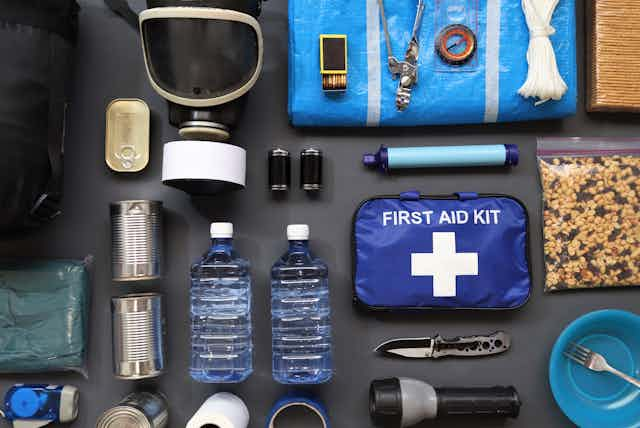What would you do if everyday life was suddenly turned upside down? Thanks to recent Hollywood blockbusters, the increasing popularity of everyday survivalism and a climate of volatile, uncertain times (war, weather, accelerating technology), visions of the apocalypse seem to be having a moment.
Preppers – those who store food, water and supplies to survive impending disaster – have a bit of an image problem. Ridiculed for their delusional end-of-the world outlook, they are caricatured as “tin foil hat-wearing loons”. But is their approach to self-sufficiency so extreme? Recently, we’ve seen energy companies warn about blackouts, urging people to plan for when the lights go out.
In this context, looming (and actual) threats from climate disruption, extreme weather, global pandemics, cyberattacks and AI have led the UK government to launch its ambitious resilience framework.
This framework is based on three core principles: a shared understanding of risk, a greater emphasis on preparation and prevention, and establishing resilience as a “whole of society” endeavour. Everyone is encouraged to be prepared.
Read more: Living with bunker builders: doomsday prepping in the age of coronavirus
In the new guidance, households are urged to stockpile items such as radios and candles, and have ample food in case disaster strikes. But this blanket whole of society call to preparedness rings hollow for many people who feel burned by past vague government directives.
In the run up to Britain’s exit from the EU, for example, fears arose surrounding the collapse of supply chains. The ongoing availability of everyday consumer goods was questioned. Despite officials dismissing stockpiling as unnecessary, the fact is one-in-five Britons began prepping.
Many consumers secretly stashed essential items – tinned food, toilet paper, batteries – driven by stigma surrounding “tin foil hat” preppers (more usually associated with bunker-culture, calamity and doomsday scenarios). However, the government has seemingly reversed its stance, and is now sounding the alarm about imminent crises, and – more importantly – how we are all individually responsible for being prepared.
As a group of academics researching shifts in prepping, covering Brexit, COVID-19, and now the cost of living crisis, our collective work explores how consumers practise everyday resilience and preparedness.

Women, responsibility and division
Newspaper articles and our own research on UK Brexit preppers suggest that women disproportionately bear the weight of home-based preparedness.
Domestic and emotional issues fall squarely on mothers who are tasked with keeping households running, no matter the circumstances. Whether ensuring everyone eats during shortages or soothing worries when the lights go out, women carry an outsized caretaking burden pivotal to family survival. All while navigating their own stresses and anxieties.
Recommendations around resilience underestimate the invisible and emotional labour needed to implement contingency planning, scanning the horizon for the next crisis. Rather than empowering households, the push toward self-sufficient readiness fuels deeper anxiety around loved ones’ safety. And if disaster strikes, support beyond immediate family remains essential.
Despite the resilience framework promoting a whole of society approach, preparedness inevitably develops into a scenario of haves and have-nots (meaning, those with the spare cash, space and time to prepare, and those who do not). This lays the foundations for inequality, resentment and the erosion of communal ties.
Our research on Brexit-prepping mothers highlights the stigma that they directed towards the unprepared (who they vilified as lazy and feckless for failing to shield children from risk). What resulted was families taking individual action to preserve their own resilience, which we believe has two implications for the resilience framework.
First, focus on individual resilience risks fuelling an “everyone for themselves” mentality. The prepared will put their own families’ needs above others. In our research with Brexit preppers, envisaged disruption led mothers to anticipate difficult decisions surrounding who they would and would not offer help should disaster strike.
In our research study ordinary, upstanding community members (such as teachers and parish councillors) imagined allowing children of the unprepared to go hungry, or considered exploiting others’ unpreparedness on the black market (selling surplus food and supplies at extortionate prices).
Pushed to the edge, they fortified their homes and armed themselves to fend off potential looters who lacked the foresight to prep. Anna, for example, discussed using her archery skills to fend off possible looters: “I’m actually an archer, so I have a bow and arrow in the garage. And I’m a bloody good shot, I’m not kidding. I’d need to protect the family.”
Second, the ability to be “prepared” risks becoming tightly bound up with dominant norms of privilege and “good”, middle-class motherhood. These are the mothers mostly likely to possess the wealth, time, skills and physical space to prep.
Those left out
Conversely, the less privileged, such as those experiencing housing issues and precarious employment, who often live hand to mouth, will be less able to prepare. Their survival is likely focused on the everyday, rather than planning for a possible eventuality. Inevitably, they will need wider support from the community, which the resilience framework, given its individualised approach to risk, does not fully consider.
While secrecy around prepping aims to safeguard accumulated assets from prospective thieves, it also isolates at-risk groups who lack equal means to stockpile for themselves. What duty do neighbours have to share with others if catastrophe (or even a temporary glitch) occurs? The line between rational self interest and morality blurs when survival instincts kick in, yet interconnected resilience may suffer when social cohesion frays beyond repair.
The government may encourage readiness across the whole of society, but this rings hollow if resilience is pursued through the stigma and separation of haves versus have-nots. Promoting preparedness without addressing inequalities, communal ties, emotional resilience and the gendered nature of caretaking labour undermines social cohesion critical for weathering crises.
Real security arises not from isolated stockpiles and individual action, but the establishment of more community-wide plans for preparedness in the event of disaster.

